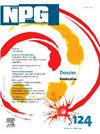临床超声:老年人的机会和局限性
Q4 Medicine
引用次数: 0
摘要
临床超声,又称 POCUS(护理点超声造影),目前发展势头迅猛。它包括由非放射科医生直接在病人床边进行超声扫描,以回答特定问题。由于其非侵入性和执行速度快,其使用范围正在迅速扩大,尤其是在重症监护和急诊科。本综述旨在探讨临床超声在医院老年患者中的应用和局限性。我们研究了临床超声波在老年人中的各个应用领域:评估血容量的血流动力学超声波、调查急性呼吸困难的胸部超声波、急性肾功能衰竭的肾脏超声波以及检测深静脉血栓的血管超声波。然而,有关临床超声波在老年人中应用的具体数据却很少。临床超声培训是必不可少的,通过短期培训可以迅速掌握自主操作所需的技能。临床超声波的主要优点是无辐射、使用和学习快捷,而且可以在病人床边使用,因此特别适合老年人使用,因为老年人通常行动不便,容易出现沮丧症状。临床超声造影,又称 POCUS(护理点超声造影),目前正在经历重大发展。它是指由非放射科医生直接在病人床边进行超声扫描,以解决特定问题。由于其非侵入性和结果迅速的特点,其使用范围正在迅速扩大,尤其是在重症监护和急诊科。本综述旨在研究临床超声在住院老年人群中的应用和局限性。我们探讨了临床超声波检查在老年人中的各种应用:评估血容量的血液动力学超声波检查、调查急性呼吸困难的胸部超声波检查、急性肾功能衰竭的肾脏超声波检查以及检测深静脉血栓的血管超声波检查。然而,有关老年患者使用临床超声的具体数据却很有限。临床超声造影的培训至关重要,而短期课程则提供了掌握自主技能所需的机会。临床超声波的主要优点是获取和使用快捷、无辐射、可在病人床边使用,因此特别适用于老年人,因为他们通常行动不便,症状不明显。它可以实时显示人体内部结构,便于早期准确诊断和跟踪各种病症。本文章由计算机程序翻译,如有差异,请以英文原文为准。
L’échographie clinique : opportunités et limites chez le sujet âgé
L’échographie clinique, également connue sous le nom de POCUS (point-of-care ultrasonography), connaît actuellement un essor significatif. Elle consiste à réaliser une échographie directement au chevet du patient, effectuée par un médecin non radiologue, dans le but de répondre à une question spécifique. Son utilisation est en pleine expansion notamment dans les services de réanimation et d’urgences en raison de son caractère non invasif et de sa rapidité d’exécution. Cette revue se propose d’explorer les applications et les limites de l’échographie clinique chez les personnes âgées hospitalisées. Nous avons examiné divers domaines d’application de l’échographie clinique chez les personnes âgées : l’échographie hémodynamique pour évaluer la volémie, l’échographie thoracique dans l’investigation de la dyspnée aiguë, l’échographie rénale dans le contexte de l’insuffisance rénale aiguë, et l’échographie vasculaire pour la détection de thrombose veineuse profonde. Cependant, il existe peu de données spécifiques sur l’utilisation de l’échographie clinique chez les personnes âgées. La formation à l’échographie clinique s’avère indispensable, et une formation courte offre la possibilité d’acquérir rapidement les compétences nécessaires pour devenir autonome. L’avantage majeur de l’échographie clinique réside dans son caractère non irradiant, sa rapidité d’utilisation et d’apprentissage, et son usage au lit du malade, ce qui la rend particulièrement adaptée à un emploi chez les personnes âgées, souvent moins mobiles et sujettes à des symptômes frustes. Elle permet une visualisation en temps réel des structures internes du corps, facilitant ainsi un diagnostic précoce et précis, ainsi que le suivi de diverses conditions médicales.
Clinical ultrasonography, also known as POCUS (point-of-care ultrasonography), is currently experiencing significant development. It involves performing an ultrasound scan directly at the patient's bedside by a non-radiologist, to address a specific question. Its utilization is expanding rapidly, particularly in intensive care and emergency departments, owing to its non-invasive nature and prompt results. The aim of this review is to examine the applications and limitations of clinical ultrasound in the hospitalized geriatric population. We explored various applications of clinical ultrasonography among older adults: hemodynamic ultrasonography for the assessment of blood volume, thoracic ultrasonography for the investigation of acute dyspnea, renal ultrasonography in the context of acute renal failure, and vascular ultrasonography for the detection of deep vein thrombosis. However, there is limited specific data regarding the use of clinical ultrasound among geriatric patients. Training in clinical ultrasonography is crucial, and a short course provides the opportunity to acquire the skills required to become autonomous. The main advantage of clinical ultrasound is that it is quick to acquire and to use, non-irradiating, and can be used at the patient's bedside, making it particularly suitable to use with older adults, who often have reduced mobility and experience rather unspecific symptoms. It enables real-time visualization of the body's internal structures, facilitating early and accurate diagnosis and follow-up of various medical conditions.
求助全文
通过发布文献求助,成功后即可免费获取论文全文。
去求助
来源期刊

NPG Neurologie - Psychiatrie - Geriatrie
Medicine-Neurology (clinical)
CiteScore
0.60
自引率
0.00%
发文量
64
审稿时长
34 days
期刊介绍:
Aux confins de la neurologie, de la psychiatrie et de la gériatrie, NPG propose a tous les acteurs de la prise en charge du vieillissement cérébral normal et pathologique, des développements récents et adaptés a leur pratique clinique.
 求助内容:
求助内容: 应助结果提醒方式:
应助结果提醒方式:


